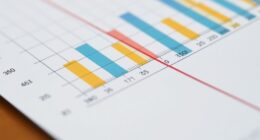To avoid misinterpreting data, focus on understanding its context and don’t rely solely on visuals. Be cautious of misleading charts, scales, and cherry-picked info. Watch out for confounding factors and remember that correlation doesn’t mean causation. Question initial assumptions and consider alternative explanations. By paying attention to these details, you’ll make smarter decisions. If you keep exploring, you’ll discover how to analyze data more accurately and avoid common mistakes.
Key Takeaways
- Always consider the broader context and underlying patterns before drawing conclusions from data.
- Use clear, accurate visualizations to prevent misleading interpretations and emphasize true trends.
- Be aware of confounding variables and avoid assuming causation from mere correlation.
- Combine statistical analysis with visual tools to reveal authentic relationships and avoid bias.
- Question data sources and presentation methods to ensure decisions are based on reliable, well-understood information.

Have you ever wondered why some projects or tasks falter despite your best efforts? Often, the root cause lies in misinterpreting data. When you’re working with numbers, it’s easy to fall into statistical pitfalls that skew your understanding and lead you astray. Recognizing these pitfalls is essential to making informed decisions. One common mistake is relying solely on raw data without proper context or analysis. Numbers can be misleading if you don’t understand the underlying patterns or the limitations of your data set. For example, small sample sizes can produce results that seem significant but are actually just anomalies. It’s critical to question whether the data truly represents the broader picture before drawing conclusions.
Data visualization plays a pivotal role in avoiding these errors. When used correctly, it transforms complex data into clear, understandable visuals that highlight true trends and relationships. But beware—poorly designed visualizations can have the opposite effect, emphasizing misleading patterns or obscuring important details. Charts and graphs should be simple, accurate, and appropriately labeled, ensuring they accurately depict the data’s story. For instance, using an inappropriate scale or cherry-picking data points can create false impressions that skew your understanding. Always double-check your visualizations to ensure they don’t exaggerate or minimize the significance of certain data points.
Another statistical pitfall involves ignoring confounding variables that influence your results. You might see a correlation between two variables and assume a causal relationship, but that’s often not the case. Failing to account for external factors can lead to incorrect assumptions and misguided strategies. It’s essential to analyze whether other variables could be affecting your data before jumping to conclusions. Additionally, confirmation bias can trap you into seeing what you want in the data rather than what it truly shows. Be open to alternative explanations and challenge your initial hypotheses to avoid this trap.
Finally, remember that data interpretation isn’t just about numbers—it’s about understanding the story they tell. Combining solid statistical analysis with effective data visualization helps you see the full picture clearly. Leveraging AI analytics tools can further enhance your ability to interpret data accurately and identify deeper insights. By being aware of common statistical pitfalls, questioning how your data is presented, and ensuring your visualizations accurately reflect the facts, you’ll reduce the risk of misinterpretation. This approach enables you to make smarter, evidence-based decisions, ultimately guiding your projects toward success rather than failure.
Frequently Asked Questions
How Can I Identify Biased Data Sources Effectively?
To identify biased data sources effectively, you should evaluate source credibility by checking the author’s expertise and reputation. Look for bias detection signals like one-sided language or missing context. Cross-reference data with reputable, independent sources to confirm accuracy. Be cautious of sources that push specific agendas or lack transparent methodology. By critically analyzing these aspects, you can better determine if a source is biased and avoid misleading information.
What Are the Best Tools for Data Visualization Accuracy?
You should prioritize tools that offer interactive dashboards and effective color coding techniques. These features help you visualize data clearly, identify patterns easily, and reduce misinterpretation. Platforms like Tableau, Power BI, and QlikView excel in providing interactive, customizable visualizations. By leveraging these tools, you can guarantee your data presentation remains accurate, engaging, and easy to interpret, making informed decisions with confidence and precision.
How Does Sample Size Influence Data Interpretation?
Your sample size directly impacts data reliability and how you interpret results. A small sample may lead to inaccurate conclusions because it doesn’t represent the whole population well, increasing the risk of bias. Conversely, a larger sample size provides more reliable data, reducing variability and giving you a clearer picture. Always guarantee you choose an appropriate sample size to avoid misinterpretation and strengthen the validity of your analysis.
What Are Common Statistical Misconceptions in Data Analysis?
You often fall into correlation fallacies or confuse causation with mere correlation. It’s easy to assume two variables are linked causally just because they move together, but that’s a misconception. Always question whether there’s a direct cause or if an external factor is at play. Remember, correlation doesn’t prove causation, and misinterpreting this can lead to faulty conclusions in your data analysis.
How Can I Prevent Overgeneralizing From Limited Data?
If you’re working with limited data, avoid overgeneralizing by ensuring your sample is representative and conducting contextual analysis. For example, if a small survey suggests a new product’s popularity, check if the sample reflects your target audience’s demographics. This approach helps prevent false assumptions and supports accurate conclusions, making your analysis more reliable. Always question whether your data truly represents the broader population before drawing sweeping claims.
Conclusion
To wrap up, being mindful of data interpretation helps you avoid costly mistakes. Remember, a recent survey found that 60% of decision-makers misread data insights, leading to flawed strategies. By double-checking your analysis and questioning assumptions, you can guarantee your conclusions are accurate. Don’t let misinterpretation derail your efforts—stay vigilant and critical. When you understand the importance of accurate data reading, you make smarter choices that drive real success.










